Theme: “Articulation phonetics. Classification of vowels and consonants
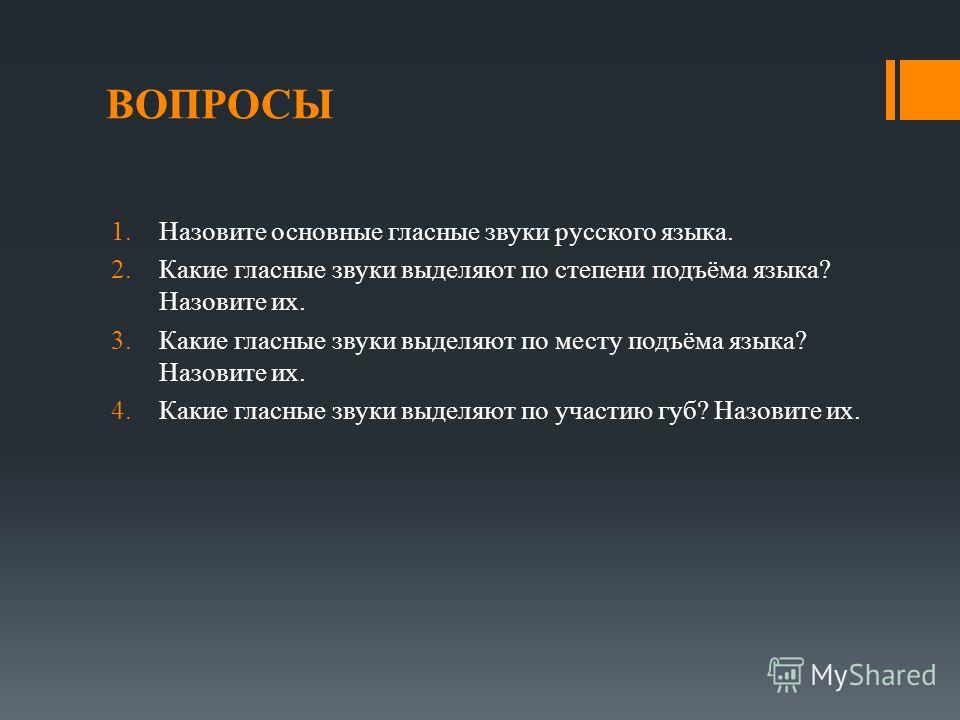
Plan:
Articulation classification of vowels
Articulation classification of consonants
The structure and work of the pronunciation apparatus.
Articulation classification of sounds of the Russian language.
The structure and operation of the speech apparatus
Plotter includes the following organs.
1. Lungs , supplying the necessary air for the formation of sounds.
2. Larynx , in which the air stream through the bronchi and trachea enters from the lungs. The larynx is a tube formed by the joining of three cartilages. The main part of the larynx in terms of sound vocal cords - two elastic folds, moving under the influence of muscles enclosed in them.
3. Epiglottis cavities - pharyngeal cavity, oral cavity and nasal cavity. They all play the role of resonators. The concept of articulation in the true sense of the word is connected with resonator cavities. Pharynxin the formation of sounds of the Russian language plays a minor role (there are languages in which its meaning is much greater). The main role in sound production belongs oral cavity.The cavity resonator changes its configuration all the time thanks to the movements of the tongue and lips.
The most mobile organ in the oral cavity is tongue . Its root (base), it is connected with the epiglottis. The side of the tongue facing the palate is called backrest.In phonetics adopted (of course, conditionally) distinguish frontthe back portion facing the front teeth averagethe part facing the hard palate and back,lying opposite the soft palate. The front part of the tongue is called horseman. WITHthe movements of the language as a whole and its parts are connected with the finest differentiation of sounds.
The front border of the oral cavity form lips - upper and more mobile lower. When a consonant is formed, the latter merges with the upper lip or moves closer to the upper teeth. When vowels are formed, the lips are drawn into a tube, rounded or stretched to the sides.
The fixed front border of the oral cavity are teeth - upper and lower. When approaching or closing with the teeth of the front of the back of the tongue or lower lip, a characteristic consonant noise occurs.
The upper boundary of the oral cavity and at the same time the boundary between the cavities of the mouth and nose is sky - hard and soft. Solid skystarts for alveoli - tubercles above the upper teeth.
It is conventionally divided into the anterior and middle palate. Softpalate back palate) -this is a muscle formation that makes up the back of the mouth. It ends with a small tongue. The soft palate is otherwise called palate curtainIn the lowered position, the palatine curtain opens to the air stream access to the nasal cavity; so are the nasal sounds. With a raised curtain, air does not get into the nasal cavity; so are all the other sounds. Nasal cavity when the palate is lowered, it acts as a resonator. A specific tone, the nasal resonance, joins the musical tone and the noise that occurs in the oral cavity.
Depending on the role of speech organs in sound formation, they are divided into active and passive. Active(or acting) organs make these or other movements necessary for the formation of speech sounds. These include the vocal cords, the palate, the tongue and the lips. To immobile passiveorgans include a hard palate, teeth and nasal cavity.
Articulation classification of sounds of the Russian language.
The sounds of speech are divided into vowels and consonants.
Vowel - this is a sound, during articulation of which the air jet passes freely through the speech path, without encountering any obstacles.
When a normal, unstable voice is formed, the vocal cords are tense and vibrate. The quality of the vowels depends on the configuration of the vocal tract organs. The air flow through the voice path can be modulated in three ways. As a result of modulations, the energy of the air flow in a certain part of it is converted into acoustic oscillations. The most powerful source of acoustic energy is the larynx, in the cavity of which there is a kind of oscillatory motion generator - vocal cords (two elastic folds). The latter come into oscillatory movements under the presence of a number of conditions: a sufficient amount of subglomeral pressure, mixing, and the corresponding tension of the vocal cords. With regard to the work of the vocal cords, as a rule, they talk about phonation.
When describing articulation of vowels usually proceed from the position of the tongue, lips, soft palate. In the process of articulation of vowels, the intensity of articulation is distributed over the entire area of the vocal tract. The force of the exhaled jet is negligible. The specificity of vowel articulation depends on the position of the active organs of speech - lips, tongue, soft palate, small tongue - uvula in relation to passive organs - teeth, alveoli, hard palate.
Consonant - it is a sound, which, when pronounced in the vocal tract by active organs of articulation, forms a barrier. The organs of speech production at the moment of overcoming the obstacles are strained. The force of the air flow is significant. First of all, this refers to the pronunciation of deaf consonants. The particular quality of consonants depends on the type of noise that occurs when, for example, the tongue, lips, or small tongue obstruct the flow of air. When articulating a consonant, the air modulation mechanism is reduced to the occurrence of turbulence in the flow of air passing through the voice path. A distinctive characteristic of consonant articulation is the intensity of the vocal tract. This tension is especially clearly localized at the site of the barrier. The force of the exhaled air stream, i.e. degree of airiness, more consonants than vowels.
Articulation classification of vowels
Articulation classification of vowel sounds is based on three signs:
1) the degree of advancement of the language forward or move backward horizontally ( row );
2) the degree of elevation of the language vertically in relation to the sky ( rise );
3) lip involvement.
1) Vowels are divided by row into:
The vowels of the anterior row (the body of the tongue is in the front of the mouth, its middle part is raised to the hard palate) - and, uh;
The vowels of the middle row (the tongue is not advanced, not drawn, the middle and back parts of the tongue are raised so that its surface is flat) - s, a, b;
The vowels of the back row (the body of the tongue is in the back of the mouth, the back of the tongue is raised to the soft palate) - oh oh
1. Phonetics. The subject of the study of phonetics.
Phonetics - (Greek. Background - sound) - the study of the sound system of a language, a section of linguistics, which studies the sound means of a language (sounds, stress, intonation). A special section of phonetics - orthoepy describes a set of norms of literary pronunciation. Orthoepy occupies a special place among linguistic disciplines. It studies those units of language that have no meaning, but they determine the existence of meaningful units of language.
[a] - does not matter, but can be grammar units.
There may also be lexical units. (BUT?)
Thus, morphology, syntax, lexicology study language units that have lexical meaning. Phonetics studies language units that have no lexical meaning, but serve to distinguish between units of grammar and vocabulary. Moreover, some linguistic phenomena are located on the border of phonetics and grammar, since it is impossible to correctly determine the basis of the word without knowing the phonetic laws.
Depending on the objectives of the study, phonetics are distinguished:
Private and general;
Descriptive and historical;
Comparative;
Experimental;
Sociophonetics.
Private phonetics deals with the study of the sound system of a particular language, general studies of general laws. Descriptive studies the phonetic system of a language in a certain period of its development. Historical studies changes in the sound system of the language throughout its history. Comparison. studies the phonetic structure of several languages. Sociophonetics studies the peculiarities of the pronunciation of certain groups of the population. An expert. learns language through experiments.
Speech sounds are studied in the section of linguistics, which is called phonetics.
All sounds of speech are divided into two groups: vowels and consonants.
Vowel sounds can be in strong and weak positions.
A strong position is a position under the stress, the sound in it is pronounced distinctly, long, with greater force and does not require verification, for example: city, land, greatness.
In a weak position (without accent), the sound is pronounced indistinctly, briefly, with less force and requires verification, for example: head, forest, teacher.
Under the stress are distinguished all six vowel sounds.
In the unstressed position, instead of [a], [o], [3], in the same part of the word, other vowel sounds are pronounced.
Thus, instead of [o], a slightly weakened sound [a] - [vad] a is pronounced, instead of [e] and [a] in unstressed syllables, [ee] is pronounced - the sound is average between [and] and [e], for example: [ m "iesta], [h" iesy], [n "itat" brka], [s * ielo].
The alternation of strong and weak positions of vowel sounds in the same part of a word is called positional alternation of sounds. The pronunciation of vowel sounds depends on which syllable they are in relation to the stressed one.
In the first pre-stressed syllable, the vowel sounds change less, for example: article [o] l - article [a] la.
In the rest of the unstressed syllables, the vowels change more, and some do not differ at all and in pronunciation they approach zero sound, for example ^: moved - [n "yriev" 6s], gardener - [sdavot], water carrier - [vdavbs] (here denote an obscure sound, zero sound).
The alternation of vowel sounds in the strong and weak positions in the letter does not reflect, for example: to be surprised is a miracle; in the unstressed position, the letter is written that designates the percussion sound in this root: to be surprised means “to meet the div (miracle)”.
This is the leading principle of Russian spelling - morphological, providing for the uniform spelling of significant parts of a word - root, prefix, suffix, ending regardless of position. The morphological principle is subject to the designation of unstressed vowels, checked by stress.
In Russian, 36 consonant sounds.
Consonant sounds of the Russian language are those sounds, during the formation of which the air meets an obstacle in the oral cavity, they consist of voice and noise or only noise.
In the first case, voiced consonants are formed, in the second - deaf. Most often, voiced and deaf consonants form pairs according to voicing-deafness: [b] - [n], [c] - [f], [g] - [k], [d] - [t], [g] - [ w], [s] - [s].
However, some consonants are only deaf: [x], [q], [h "], [w] or only voiced: [l], [m], [n], [p], [T]. Distinguish also solid and soft consonants. Most of them form pairs: [b] - [b "], [c] - [c"], [d] - [g "], [d] - [d"], [c] - [з "], [к] - [к"], [л] - [л "], [м] - [м *], [н] - [н *], [п] - [п"], [р] - [р "], [с] - [с"], [t] - [t "], [ф] - [ф"], [х] - [х "]. They do not have solid paired sounds consonants [g], [br], [q] and soft consonants, [h "], [t"].
In a word, consonants can occupy different positions, i.e., the location of the sound among other sounds in the word.
The position at which the sound does not change is strong. For a consonant, this is the position in front of the vowel (weak), sonorous (true), before [in] and [in *] (twisted). All other positions are for consonants weak.
At the same time, the consonant sound changes: the voiced before the deaf becomes deaf: hem - [Patsyt "]; the deaf before the voiced becomes voiced: please - [prbz" ba]; ringing at the end of the word stuns: oak - [dup]; sound is not pronounced: holiday - [praz "n" ik]; hard before soft can become soft: power - [vlas "t"].
QUESTIONS 1. Name the main vowel sounds of the Russian language. 2. What vowel sounds are distinguished by the degree of lifting the language? Call them. 3. What are the vowel sounds emit at the place of lifting the language? Call them. 4.What vowel sounds are allocated by the participation of the lips? Call them.

In Russian, there are 6 basic vowel sounds: [a], [o], [e], [u], [y], [y]. Classification of vowel sounds can be presented in the form of a table: Classification of vowel sounds ClimbingFirst front middle series Upper Upper [and] [s] [y] Medium [e] [o] Bottom [a] non-labialLabialized
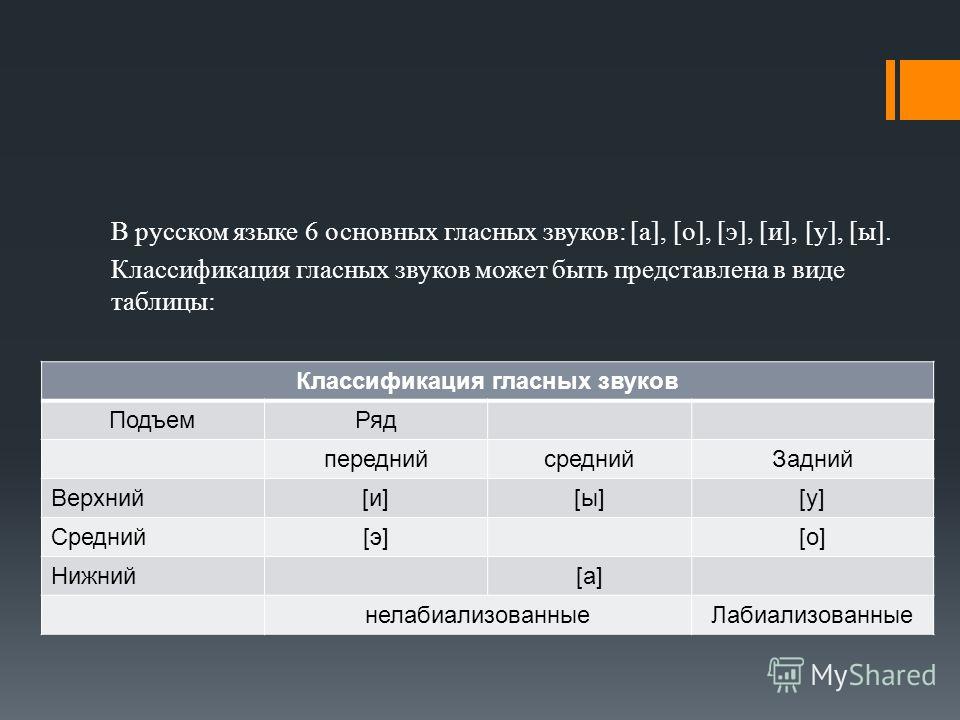
The classification of vowel sounds is based on articulation signs: the degree of elevation of the language vertically: upper, middle, lower; a row (a place of lifting the tongue horizontally): front, middle, back; lip involvement: labial and non-labial sounds. According to the degree of elevation of the tongue, vowels are divided into vowels: a) of the upper elevation - [and], [s], [y]; b) medium rise - [e], [o]; c) lower lift - [a].
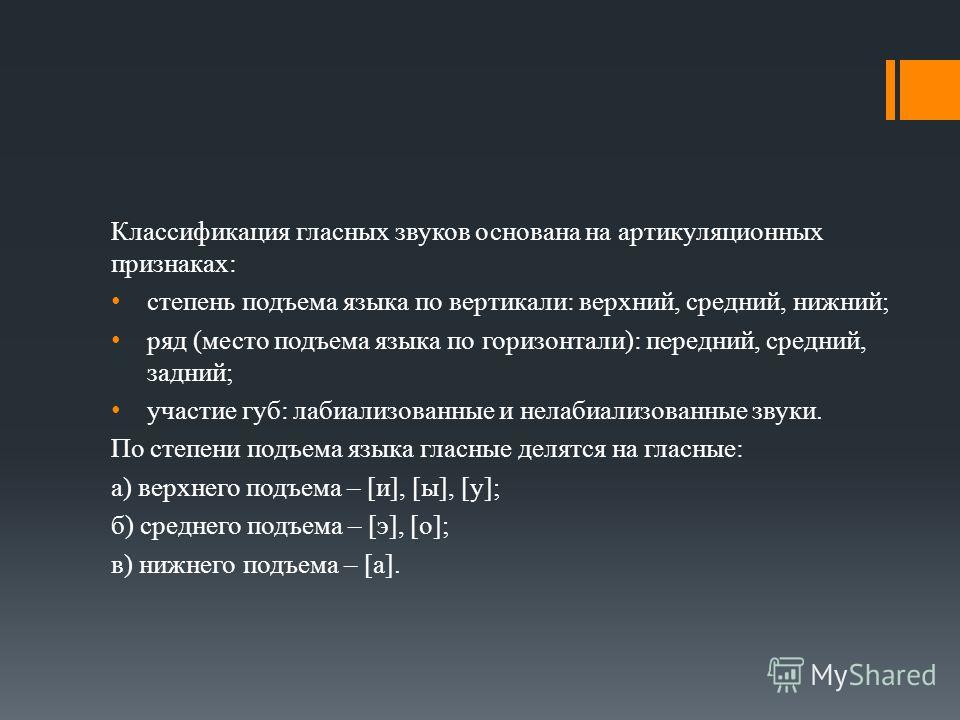
When pronounced sounds of the upper lift ([and], [s], [y]), the lower jaw is raised, the tongue is raised high. Sounds of medium elevation ([e], [o]) are formed with a smaller elevation of the tongue, the lower jaw is also slightly elevated. Vowel [a] - the sound of the lower lift. It is formed with a wide solution of the mouth, the tip of the tongue is lowered and is located behind the lower teeth. The back of the tongue almost does not rise. The language is calm. According to the place of lifting the tongue, vowels are divided into vowels of a) front row - [and], [e]; b) middle row - [s], [a]; c) the back row - [y], [o].

With the formation of front vowels ([and], [e]), the whole body of the tongue moves forward, the tip of the tongue rests against the lower teeth. In the formation of middle vowels ([]], [a]), the body of the tongue is not advanced: it is in a neutral position. The sound [a] can be attributed to the vowels of the middle-back row. The vowels of the back row ([y], [o]) are pronounced with the language pushed back. By participation of lips, vowels are divided into: labialized (labial), when pronouncing which the lips are pulled forward and rounded: [o], [y]; unabialized, when pronouncing which lips are passive (i.e. all other vowels).

In addition to these basic vowel sounds, others are also spoken: [and e] - the vowel of the front-middle series, upper-middle lift, non-labialized, is used in the first pre-syllable after soft consonants: [ri e] dy, [chee] sy; [s e] - vowel of the middle tier, upper-middle lift, non-labialized, is used in some words after the solid consonants [g], [br], [c] in the first pre-syllable: [zy e] leth; [Λ] - vowel of the middle-back row, lower-middle lift, non-bialized, used in the first preemptive syllable after hard consonants or in the absolute beginning of the word: [Λ] téc; [ъ] - vowel of the middle-back row, medium rise, non-bialized, is heard in all unstressed, except the first pre-stressed, syllables after hard consonants: lé [m]; [ь] - a vowel of the front-middle row, medium rise, non-bialized, is heard in all unstressed, except the first pre-stressed, syllables after soft consonants: ó [с] нь.
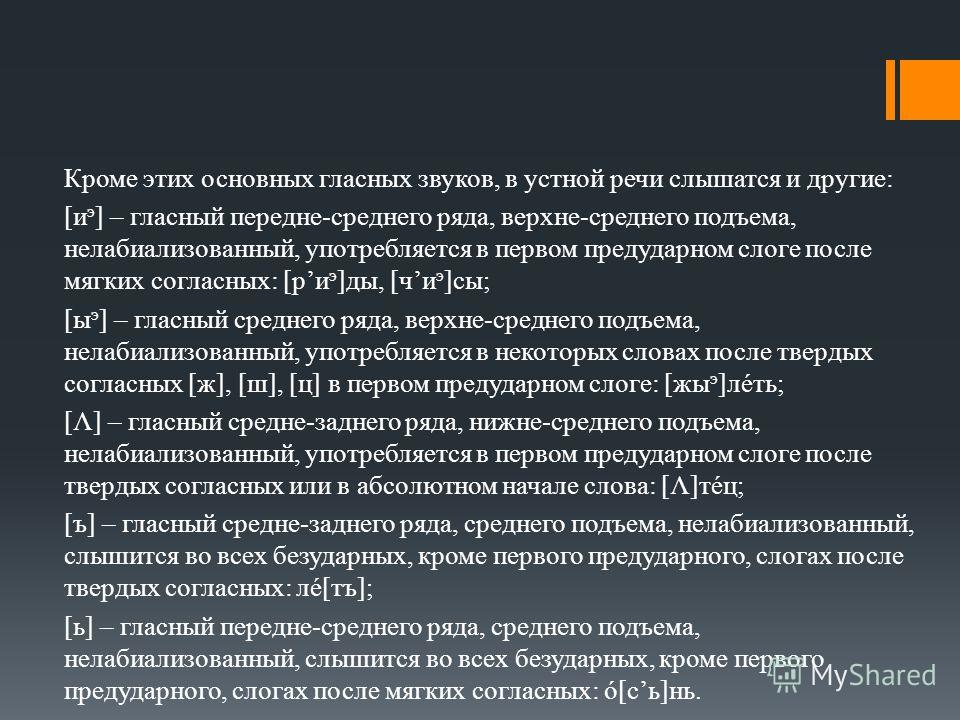
Therefore, the vowel table can be specified: This table can help us with the phonetic transcription of words and sentences when we study phonology. Classification of vowel sounds RaisingFront Anterior Anterior-Medium Middle Middle Rear Rear Upper [u] [s] [y] Upper Medium [and e] [s] Medium [e] [ь] [ъ] [o] Medium-Lower [Λ ] Lower [a] non-labialized Labialised data
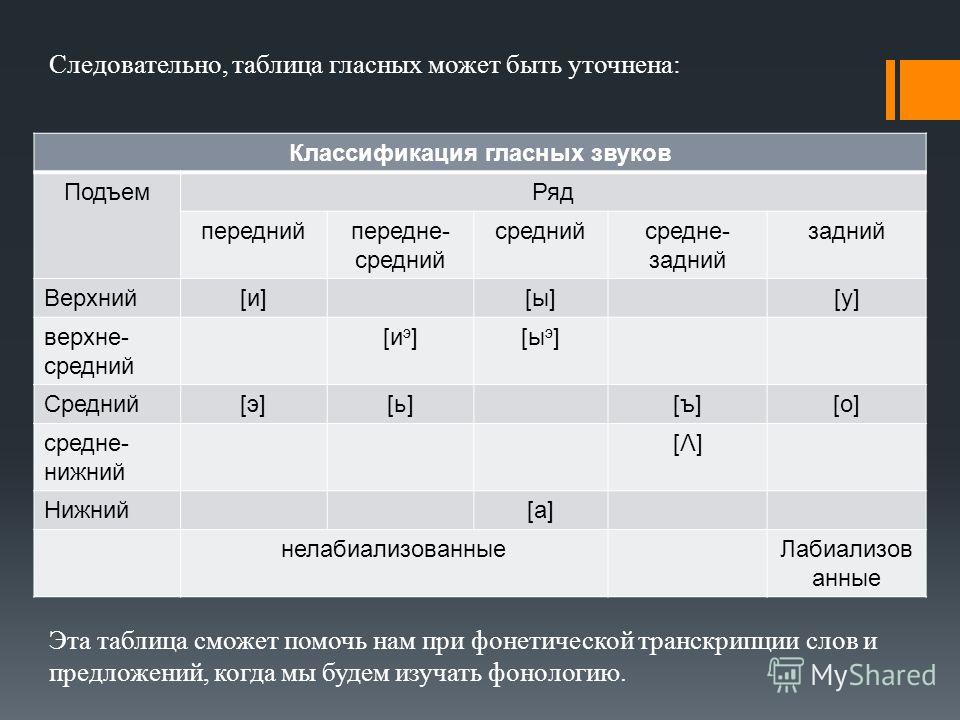
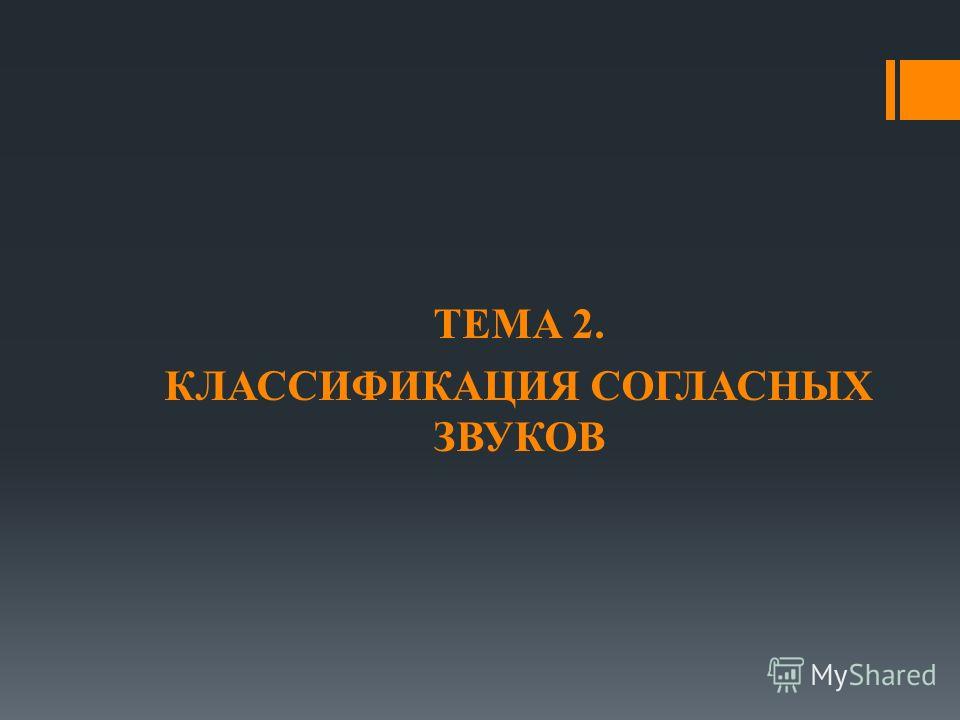
QUESTIONS 1. How many consonant sounds are distinguished in Russian? 2. By what signs are consonants classified? 3. What are the groups of consonant sounds at the place of education? 4. Name the lip-labial and lip-dental sounds. 5. What groups of consonants are distinguished from lingual sounds? 6. Name the front-lingual, middle-lingual and rear lingual sounds. 7. What are the groups of consonant sounds by the method of articulation? 8. What are stop consonants? Call them. 9. What are slotted consonants? Call them. 10. How do the occlusal consonants appear? Call them. 11. How are bowed sounds? Name the band of continuous bass sounds. 12. How are shaky consonants formed? 13. On which groups are all voices and noise agreeing to participate? 14. What are sound sounds, voiced noisy and deaf noisy sounds. Give examples. 15. Name the consonants for voicing / deafness. 16. On which groups are all consonants divided by the absence or presence of palatalization? 17. Name the pairs of consonants in hardness / softness. 18. What is consonant [j] (yot)?
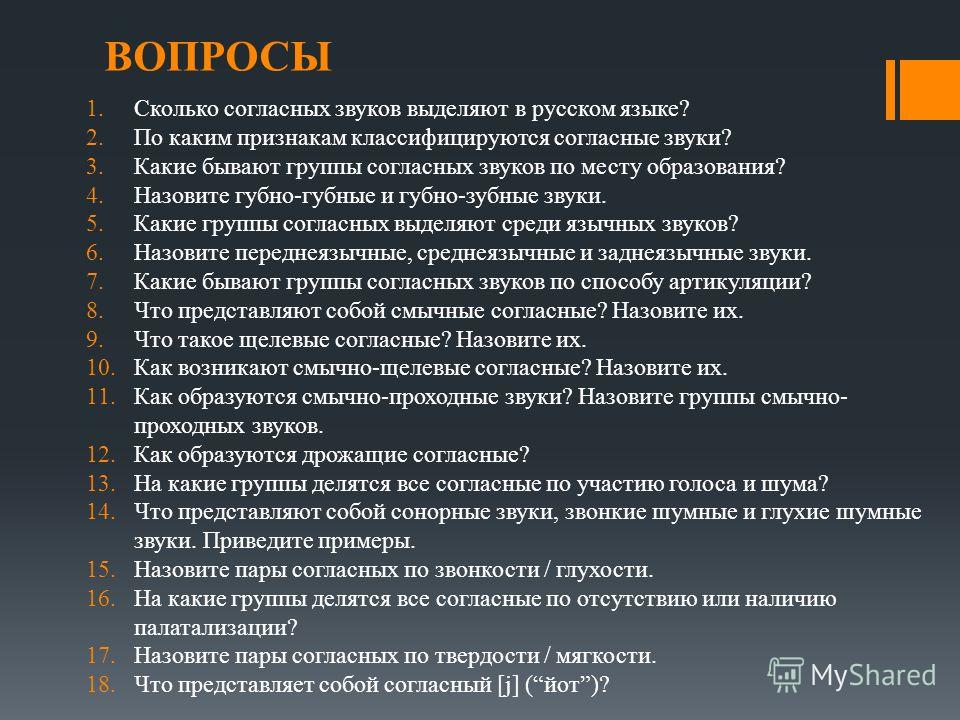
- Classification of vowels and consonants
- What is the difference between a speech therapist and a pathologist?
- Open speech therapy session in the preparatory group of a kindergarten for children with onr "Journey to the Land of Knowledge"
- What do the symbols on the flags in different countries
- Day of the state flag of the Russian Federation
- Batmen: Arkham Knight: the passage of an additional line of quests
- Sound letter analysis of the word: the difference between sounds and letters

 Live journal
Live journal Facebook
Facebook Twitter
Twitter